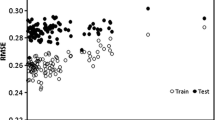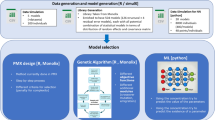Abstract
Purpose. The methodology of predicting the pharmacokinetic parameters (AUC, cmax, tmax) and the assessment of their variability in bioequivalence studies has been developed with the use of artificial neural networks.
Methods. The data sets included results of 3 distinct bioequivalence studies of oral verapamil products, involving a total of 98 subjects and 312 drug applications. The modeling process involved building feedforward/backpropagation neural networks. Models for pharmacokinetic parameter prediction were also used for the assessment of their variability and for detecting the most influential variables for selected pharmacokinetic parameters. Variables of input neurons based on logistic parameters of the bioequivalence study, clinical-biochemical parameters, and the physical examination of individuals.
Results. The average absolute prediction errors of the neural networks for AUC, cmax, and tmax prediction were: 30.54%, 39.56% and 30.74%, respectively. A sensitivity analysis demonstrated that for verapamil the three most influential variables assigned to input neurons were: total protein concentration, aspartate aminotransferase (AST) levels, and heart-rate for AUC, AST levels, total proteins and alanine aminotransferase (ALT) levels, for cmax, and the presence of food, blood pressure, and body-frame for tmax.
Conclusions. The developed methodology could supply inclusion or exclusion criteria for subjects to be included in bioequivalence studies.
Similar content being viewed by others
REFERENCES
S-C. Chow and J-P. Liu. Design and Analysis of Bioavailability and Bioequivalence Studies, Marcel Dekker, New York, 1992.
R. J. Erb. Introduction to backpropagation neural network computation. Pharm. Res. 10:165–170 (1993).
M. E. Brier, J. M. Zurada, and G. R. Aronoff. Neural network predicted peak and trough gentamicin concentrations. Pharm. Res. 12:406–412 (1995).
A. S. Hussain, R. D. Johnson, N. N. Vachharajani, and W. A. Ritschel. Feasibility of developing a neural network for prediction of human pharmacokinetic parameters from animal data. Pharm. Res. 10:466–469 (1993).
R. C. Rowe. Intelligent software systems for pharmaceutical product formulation. Pharm. Technol. Eur. 9:36–43 (1997).
E. A. Colbourn and R. C. Rowe. Modelling and optimization of a tablet formulation using neural networks and genetic algorithms. Pharm. Technol. Eur. 8:46–55 (1996).
R. Hecht-Nielsen. Neurocomputing, Addison-Wesley, Reading, MA, 1990.
W. A. Ritschel, R Akileswaran, and A. S. Hussain. Application of neural networks for the prediction of human pharmacokinetic parameters. Meth. Find. Exp. Clin. Pharmacol. 17:629–643 (1995).
B. J. A Krose and P. P. van der Smagt. An Introduction to Neural Networks, The University of Amsterdam, 1993.
A. S. Hussain, P. Shivanand, and R. D. Johnson. Application of neural computing in pharmaceutical product development: Computer aided formulation design. Drug Dev. Ind. Pharm. 20:1739–1752 (1994).
A. S. Achanta, J. G. Kowalski, and C. T. Rhodes. Artificial neural networks: Implications for pharmaceutical sciences, Drug Dev. Ind. Pharm. 21:119–155 (1995).
P. Veng-Pedersen and N. B. Modi. Neural networks in pharmaco-dynamic modeling. Is current modeling practice of complex kinetic systems at a dead end? J. Pharmacokinet. Biopharm. 20:397–412 (1992).
J. V. S. Gobburu and E. P. Chen. Artificial neural networks as a novel approach to integrated pharmacokinetic-pharmacodynamic analysis. J. Pharm. Sci. 85:505–510 (1996).
L. B. Sheiner and S. L Beal. Some suggestions for measuring predictive performance. J. Pharmacokinet. Biopharm. 9:503–512 (1981).
NNMODEL Version 1.40, User's guide, Neural Fusion, New York, 1996.
J. Zupan. Usage of computer methods in chemistry, DZS, Ljubljana, 1992.
V. W. Steinijans, R. Sauter, D. Hauschke, E. Diletti, R. Schall, H. G. Luus, M. Elze, H. Blume, C. Hoffmann, G. Franke, and W. Siegmund. Reference tables for the intrasubject coefficient of variation in bioequivalence studies. Int. J. Clin. Pharm. Ther. 33:427–430 (1995).
Author information
Authors and Affiliations
Corresponding author
Rights and permissions
About this article
Cite this article
Opara, J., Primožič, S. & Cvelbar, P. Prediction of Pharmacokinetic Parameters and the Assessment of Their Variability in Bioequivalence Studies by Artificial Neural Networks. Pharm Res 16, 944–948 (1999). https://doi.org/10.1023/A:1018857108713
Issue Date:
DOI: https://doi.org/10.1023/A:1018857108713




